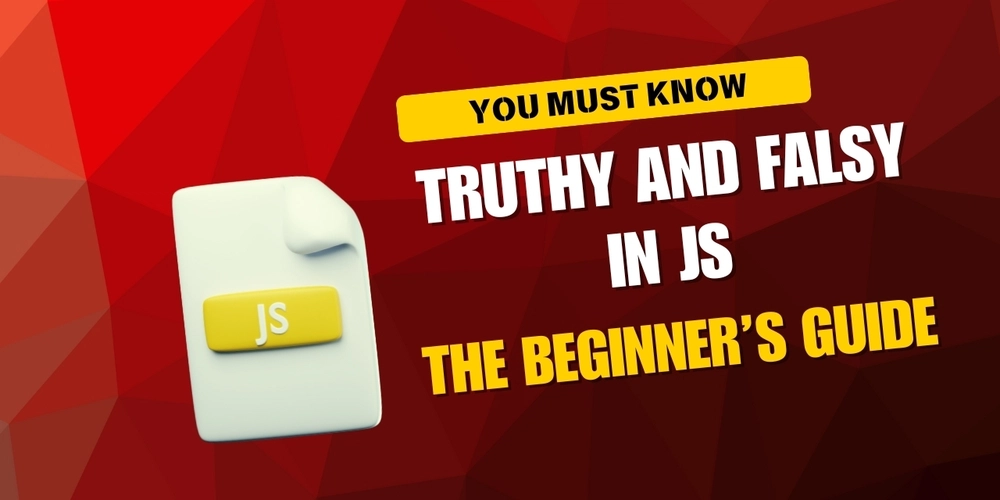Stop Guessing: Understand JavaScript Equality the Right Way
When you start working with JavaScript, one of the first things you notice is how flexible it feels. You can assign different types of values to the same variable and JavaScript won’t complain. This flexibility is great—but it can also lead to unexpected bugs, especially when you’re comparing values or checking if something is “true” or “false.”
Let’s break down some of these concepts in a beginner-friendly way so you can write safer and more predictable JavaScript code.
🟡 JavaScript Variables Are Loosely Typed
In JavaScript, you don’t need to declare the type of a variable. For example:
let x = 5; // x is a number
x = "hello"; // now x is a string
x = true; // now x is a boolean
This is called loose typing—a variable can hold any type of data, and JavaScript doesn’t stop you from changing it. While this is super convenient, it can be dangerous when you start comparing values.
Loose vs Strict Equality: What’s the Difference?
Loose Equality (==)
This operator tries to be helpful by converting values to the same type before comparing them.
0 == false // true 😬
"" == false // true 😬
"0" == 0 // true 😬
These results can be very confusing, especially for beginners!
Strict Equality (===)
This operator compares both value and type. So if the types are different, the result is false.
0 === false // false ✅
"" === false // false ✅
"0" === 0 // false ✅
🔐 Best Practice: Use
===(strict equality) instead of==to avoid weird bugs.
✅ Truthy and Falsy Values
Every value in JavaScript is either truthy or falsy when used in a Boolean context (like inside an if statement).
Falsy Values
These are the ones treated as false:
false
0
-0
0n // BigInt zero
""
null
undefined
NaN
Any other value is considered truthy.
Truthy Values Examples
"0" // a non-empty string
"false" // also a non-empty string
[] // empty array
{} // empty object
function() {} // function (even if it's empty)
😲 Surprise Alert:
[]is truthy, but[] == falseis true. Wait, what?! Let’s talk about that…
Why Comparisons Can Get Weird
Let’s look at a real example:
[] == false // true 😵💫
[] === false // false ✅
That first result is possible because JavaScript converts the empty array ([]) to a string (""), then compares it to false, which also converts to "". This is how we get weird results.
Another one:
"" == 0 // true 😬
"" === 0 // false ✅
You can quickly see how loose equality (==) can trick you.
💡 How to Stay Safe with Truthy/Falsy Values
To write clean and bug-free JavaScript, follow these simple rules:
1. Use Strict Equality (===)
Always prefer === over == unless you know exactly what you’re doing.
if (value === false) {
// do something
}
2. Convert to Boolean Explicitly
If you’re not sure whether something is truthy or falsy, convert it to a Boolean using !!:
const isValid = !!userInput;
This way, you get a real true or false value.
3. Avoid Direct Comparisons with Falsy Values
Don’t compare values directly to true or false. Instead, rely on strict equality or Boolean conversion.
Bad:
if (value == false) {
// tricky behavior
}
Good:
if (!value) {
// easier to understand
}
Or even better:
if (value === false) {
// very specific check
}
Final Thoughts
JavaScript gives you a lot of freedom, but with that comes the need for caution. By understanding how equality and truthy/falsy values work under the hood, you can:
- Avoid confusing bugs 😵
- Write clearer and safer code
💬 Tip: If you’re ever stuck, use
console.log(typeof value, value)to debug what’s going on!
✅ Summarization
Here’s a handy table to quickly identify which values are truthy and which are falsy in JavaScript:
| Value | Type | Truthy or Falsy | Notes |
|---|---|---|---|
false |
Boolean | Falsy | The literal false
|
0 |
Number | Falsy | Zero is considered falsy |
-0 |
Number | Falsy | Negative zero is also falsy |
0n |
BigInt | Falsy | BigInt zero |
"" |
String | Falsy | Empty string |
null |
Null | Falsy | Represents absence of value |
undefined |
Undefined | Falsy | Unassigned or missing value |
NaN |
Number | Falsy | “Not a Number”, often from invalid math |
"0" |
String | Truthy | Non-empty string, even if it looks like zero |
"false" |
String | Truthy | Non-empty string |
" " (space) |
String | Truthy | Contains a space character |
[] |
Array(Special Type of Object) | Truthy | Empty array (Arrays are a special type of object, which means that the typeof operator will return “object” for arrays. However, arrays have unique properties and methods that distinguish them from regular objects) |
[0] |
Array(Special Type of Object) | Truthy | Contains one element (typeof operator will return “object” for arrays) |
{} |
Object | Truthy | Empty object |
{ a: 1 } |
Object | Truthy | Non-empty object |
function() {} |
Function | Truthy | Functions are always truthy |
Infinity |
Number | Truthy | Not zero, so it’s truthy |
-Infinity |
Number | Truthy | Same as above |
true |
Boolean | Truthy | The literal true
|
42 |
Number | Truthy | Any non-zero number is truthy |
✅ Ready to Practice?
If you’re just starting out with JavaScript, understanding truthy and falsy is a huge milestone!
Try reading from other different sources.
💬 Got questions or ideas? Leave a comment — I’d love to hear from you!
📌 Follow me for beginner-friendly coding tutorials every week:

